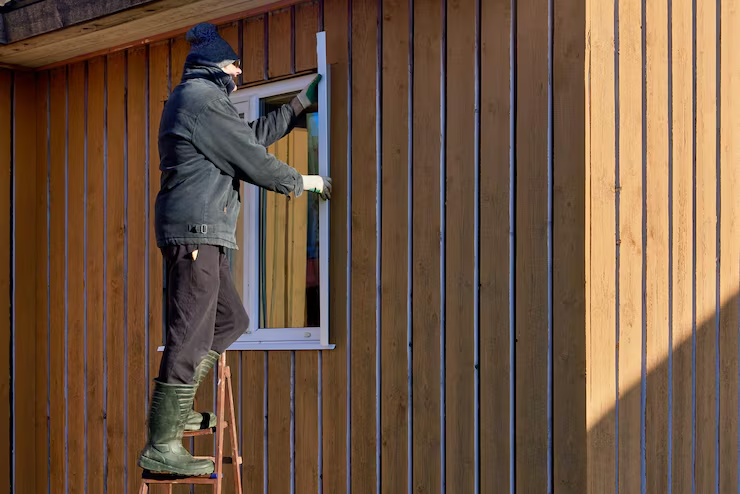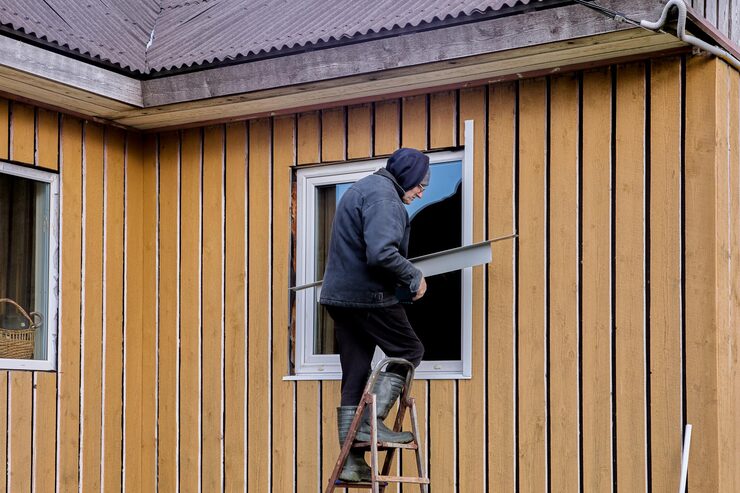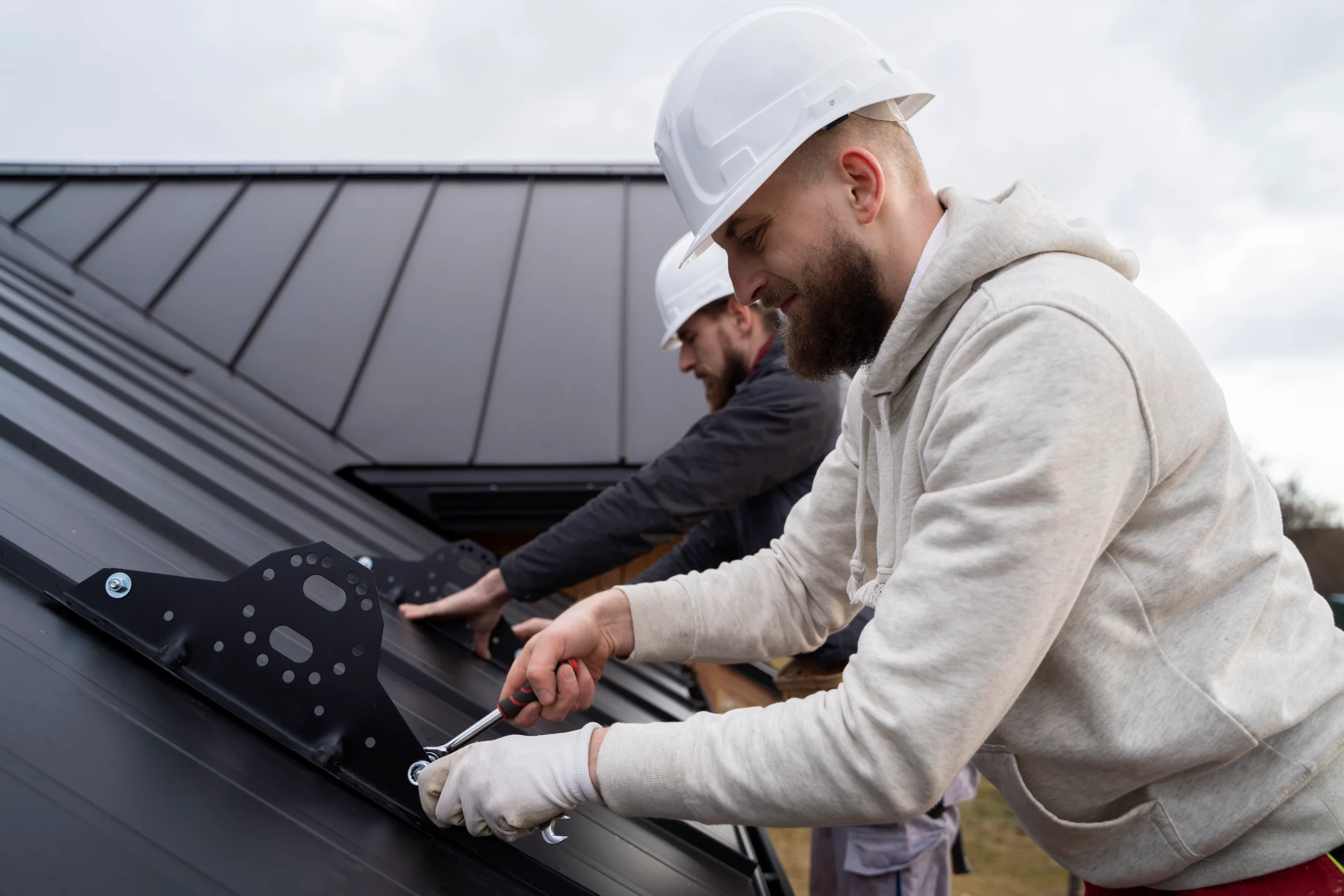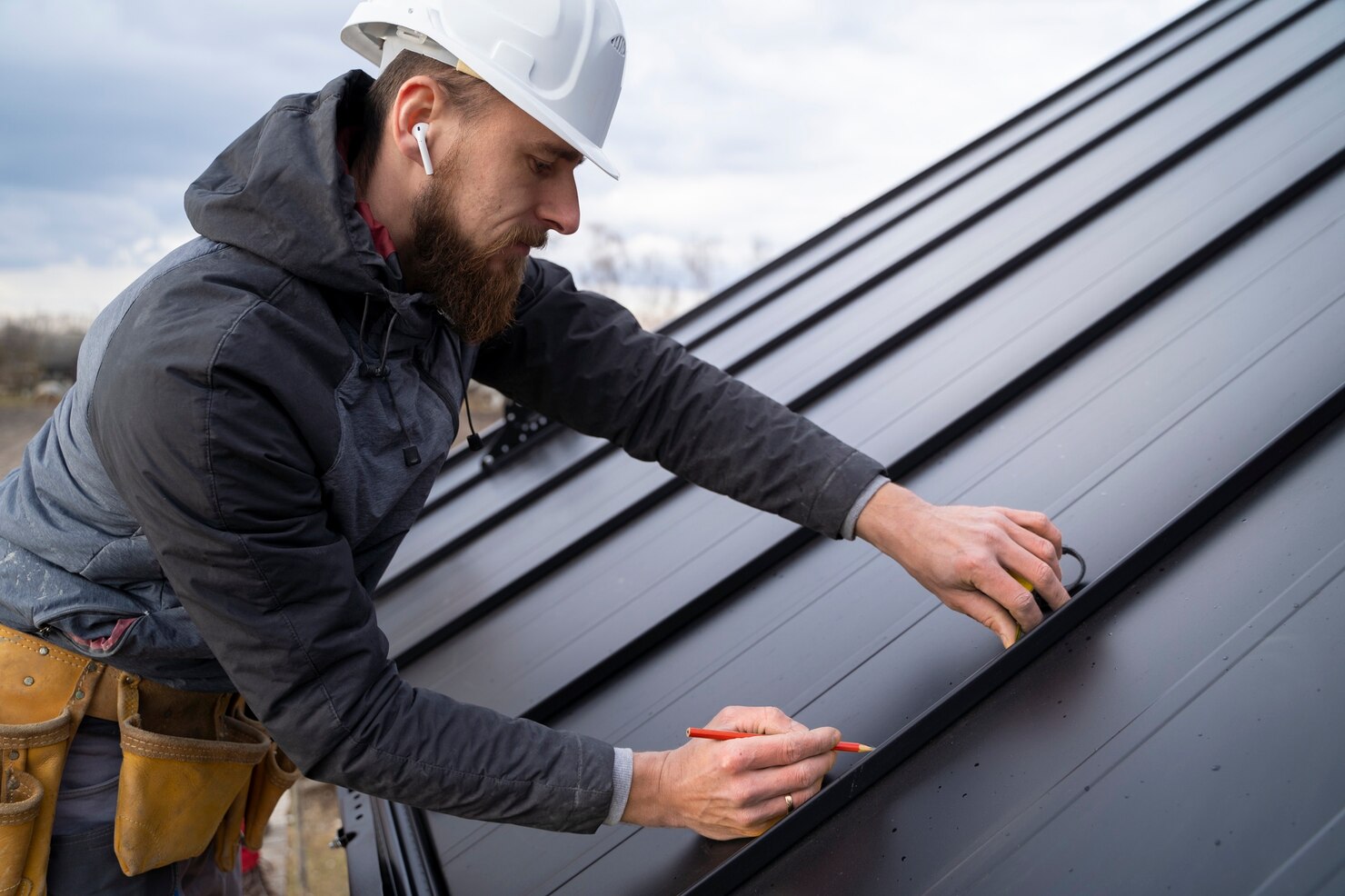Just as a roof is as good as what is on top of it, back at Cape Cod, where nor’easters, salty air, and heavy snows put a strain on every shingled roof, selecting the right one makes all the difference.
Cape Cod’s harsh coastal environment demands a roof material able to cope with high winds, ubiquitous salt spray, and ice dams in winter, yet maintain the traditional New England character of a residence. An inappropriate roof replacement material can mean costly repairs, but an appropriate one earns a residence decades of protection.
Here, we’ll discuss the best roofing materials for Cape Cod homes in 2025: durable asphalt shingles, storm-tested metal roofing, traditional cedar shakes, and low-maintenance synthetics. You’ll find out what high-quality roofing material can withstand coastal climates, what blends with traditional Cape Cod appearances, and how to balance upfront cost with decades-long value. You’ll also learn top options for steeply pitched or level roofs, such as PVC and TPO with low-pitch installations.
Need expert help finding the best roof for your home? Hire top-rated Cape Cod roofers with 50+ years of experience
Without further ado, let’s get started;
Factors to Consider When Choosing Roofing For Cape Cod Homes
Selecting the right roofing material for your Cape Cod property requires careful evaluation of six critical factors unique to our coastal environment. Having worked with hundreds of Cape homeowners and reviewed decades of installation data, we’ve identified these non-negotiable considerations:
1. Climate Resistance (The #1 Priority)
Cape Cod’s weather doesn’t play nice, and your roof takes the brunt of it. When we say climate resistance, we mean your roof’s ability to stand up to
The Big Four Threats:
- Salty Air – That ocean breeze? Silently, it is consuming brittle materials.
- Nor’easter Winds – 100+ mph gusts can peel roofs like bananas
- Ice Dams – Melting and refreezing snow creates destructive ice buildup
- Snow Loads – Heavy snow can collapse poorly supported roofs
What Works as the Best Roofing Material in Cape Cod?
| Material | Wind Rating | Salt Resistance | Ice Dam |
| Metal Roofing | ★★★★★ (130+ mph) | ★★★★ (with coating) | ★★★★(smooth surface) |
| Synthetic Slate | ★★★★ (110 mph) | ★★★★★ | ★★★ |
| Architectural Shingles | ★★★ (90 mph) | ★★ | ★★ |
Pro Tip: After the 2020 nor’easter, 92% of Barnstable homes with Miami-Dade approved metal roofs had zero damage, while standard asphalt shingle roofs averaged $8,300 in repairs.
Why This Matters Most:
Your roof isn’t just there to look pretty; it’s your home’s first line of defense against everything the Atlantic throws at us. Skimp here, and you’ll pay dearly when the next big storm hits.
2. Looks That Fit Our Cape Cod Style Home
Every home has a personality, and the roof has a lot to do with how a residence looks on the outside. On Cape Cod, with homes of character, choosing roof material that matches how a residence looks is important.
They usually look best with a cedar shake finish; it has a traditional, coastal look. You can go with real cedar or choose a synthetic one with a similar look.
Most modern homes will accept smooth steel roofing with a matte finish. It produces a newer, angular appearance.
Homes within historic districts may be mandated to conform with a group of regulations and traditional roof coverings when maintaining their historic character.
In short, you want to choose a roof that will fit within the design of your home as well as enhance the beauty of the area. Explore the best roofing contractors near you and consult them on region-specific designs.
3. How Long It Will Last
Your roof’s durability will rely on the roof material you use. This is what you can anticipate:
Longest-Lasting (50+ Years)
- Ideal material for metal roofing (steel, copper, aluminum)
- Slate (natural stone)
- High-quality synthetics (advanced polymer roofs)
- Very good for longevity, especially on colder days.
Mid-Range (25–30 Years)
- Asphalt shingles, architectural shingles, best roof material
- Good cost versus lifespan balance.
Shortest Lifespan (15–20 Years)
- Simple 3-tab shingles (cannot be used on coastline areas)
- Wears down faster, especially in salt air!
Check out our latest guide on asphalt shingles vs architectural shingles to compare roofing materials and make the best selection.
Note: Important
Salt air close to a coastline may reduce roof life by a few years!
Best flat roof material? EPDM rubber or TPO (lasts 20–30 years).
Options of metal roof? Steel (most enduring), aluminum (impenetrable to rust).
Do it once—your roof will last you as long as your house!
4. What It Will Cost
The best roof material for your wallet:
| Roofing Material | Cost per sq. ft. | Lifespan | Best For | Salt Air Durability |
| 3-Tab Asphalt Shingles | $3–$5 | 15–20 years | Budget-friendly homes | Weakest |
| Architectural Shingles | $4–$7 | 25–30 years | Balance of cost & durability | Moderate |
| Metal Roofing (Steel) | $7–$14 | 50+ years | Storms, modern/coastal homes | Strong |
| Metal Roofing (Aluminum) | $8–$16 | 50+ years | Coastal areas (rust-proof) | Best |
| TPO/EPDM (Flat Roofs) | $5–$10 | 20–30 years | Flat roofs, commercial buildings | Moderate |
| Slate Tile | $10–$25+ | 50–100+ years | Luxury historic homes | Strong |
| Copper Roofing | $15–$30+ | 70+ years | Premium, iconic looks | Best |
Smart Tip: Spending more upfront often saves money long-term.
Key Notes:
- Labor adds 40–60% to material costs
- Salt air reduces lifespan; aluminum/copper handle it best
- Best value? Steel metal roofing for most homes
Get a free quote today from trusted roofers Cape Cod with over 50 years of experience.
5. Maintenance Needs
Taking good care of your roof is important to protecting your home. Some types of roofing material need some level of maintenance, others are low maintenance, while others need maintenance on an ongoing basis. Here is just the simple rundown:
1. Low-maintenance roofs (Best for busy homeowners)
These roofs need very little maintenance to keep them strong:
- Metal Roofing [lifespan 40 to 70+]
- Slate & Tile [lifespan 50 to 100+]
- Synthetic Roofing [lifespan 30 to 50]
Moderate Maintenance (Check Now and Then)
- Asphalt shingles [Lifespan 3-tab: 15–20 years | Architectural: 25–30 years]
- Flat Roof/EPDM or TPO [Lifespan 20 to 30 years]
High-Maintenance (Requires Regular Care)
- Woodshake shake/shingles [Lifespan 20 to 30 years]
- Copper roofing [develops a patina over time; its lifespan is also 20 to 30 years]
Note for Cape Cod Homes:
Salt in the air can wear down your roof faster. Rinse it now and then to wash the salt off.
Metal roofs—especially aluminum—are the best for seaside weather.
Pro Tip: The best roofing products balance durability with easy care. If you hate maintenance, go for metal roofing options or high-quality synthetics!
6. Energy Savings
Choosing the best roofing material for energy efficiency can help you stay comfortable year-round while lowering your energy bills. Here’s what works best for our coastal climate.
1. Metal Roofing – Top Choice for Durability & Efficiency
Why Cape Cod Homes Love It:
- Reflects summer heat, reducing AC costs (10–25% savings)
- Withstands salt air better than most materials (especially aluminum)
- Sheds snow easily in winter
Best Styles: Standing seam or metal shingles (for a classic Cape look)
Color Tip: Light gray or white for max reflectivity
2. Synthetic Roofing – Cedar Shake Look Without the Maintenance
Why It Works Here:
- Mimics traditional Cape Cod cedar shakes but won’t rot or warp
- Some brands have built-in cool roof technology
Best For: Homeowners who want the classic Cape Cod-style home with modern efficiency
3. Slate or Composite Slate – Timeless & Efficient
Why It’s Great:
- Naturally insulates against both heat and cold
- Lasts 50+ years (perfect for historic Cape homes)
Downside: Heavy – check if your home’s structure can support it
4. White TPO (For Flat or Low-Slope Roofs)
Best For: Garages, home additions, or modern Cape styles
Why It Works: Reflects sunlight to keep interiors cooler
Less Efficient Options for Cape Cod
| Material | Issue | Workaround |
| Dark Asphalt Shingles | Absorbs heat in summer, fades faster in salt air | Choose lighter colors or cool roof shingles |
| Real Wood Shakes | Requires constant upkeep in salty, humid air | Synthetic versions last longer |
Cape Cod-Specific Tips for Energy Savings
- Go Lighter
- Ventilate Properly
- Salt Air Defense
Best Pick for Most Cape Cod Homes?
For a traditional look, go with synthetic cedar shake or light-colored metal shingles; for a modern or coastal style, choose standing seam metal or a white TPO roof.
Best Roofing Materials For Cape Cod Homes
Cape Cod’s coastal climate demands durable, weather-resistant roofing materials that can handle salty air, strong winds, and seasonal storms. Whether you prefer a traditional Cape Cod look or a modern coastal style, here are the best roofing materials for your home, along with their pros, cons, and ideal applications.
Top Roof Material Options for Overall Mashpee, Cape Cod
1. Metal Roofing [Standing Seam & Stone Coated Metal Roofing]
Standing Seam Metal Roofing

A roof system featuring vertically running metal panels with raised seams that interlock mechanically or through snap-together connections. The seams stand above the roof plane, created by folding adjacent panel edges together. Typically made from aluminum, steel, or copper in 16-24 foot lengths.
Pros:
- Seamless panels prevent leaks between sections
- 90% Solar reflectance meets ENERGY STAR V3 standards
- Won’t burn (top fire rating)
- Snow slides easily at a 14-degree slope
- Aluminum resists ocean salt damage
Cons:
- Needs special clips for heat expansion
- Thin panels may show wavy lines
- Can corrode if mixed with other metals
- Special paint needs perfect application
- Loud in rain without insulation
Stone-Coated Metal Roofing

Composite roof assembly made of an acrylic-modified stone granite coating over a substrate of galvanized steel. Shaped composite panels resembling aged roofing material of shingle, shake, or tile appearance are finished with colorful ceramic-coated stones that are bonded to the sheet.
Pros
- Color stays true for decades
- Withstands baseball-sized hail impacts
- 30% quieter than regular metal roofs
- Looks like real wood shakes
- Stone layer blocks sun damage
Cons
- Tiny stones may loosen over 20+ years
- More nail holes = more leak risks
- Needs extra layer to prevent sweating
- Color varies slightly between batches
- Can’t install on very flat roofs
Cost: For a standing seam metal roof, $10 to $30 per sq. ft. & for stone-coated metal roofing, $8 to $18.
Lifespan: 50+ Years
2. Synthetic Slate (Polymer/Rubber)

Pros:
- Made from tough, flexible plastic (polypropylene)
- Special sun-blocking colors stay vibrant for decades
- Solid construction won’t soak up water
- Eco-friendly options use recycled tires/rubber
- Fireproof rating (same as concrete roofs)
Cons:
- Expands/contracts more than real slate in heat/cold
- New roofs may have slight chemical smell at first
- Not very insulating (R-0.5 rating)
- Can crack in extreme cold (-20°F or below)
- Rough surface collects pollen in spring
Cost: $9–$12/sq. ft.
Lifespan: 40 to 60 Years
Best Budget-Friendly Roofing Material Options
3. Architectural Asphalt Shingles

Pros:
- Fiberglass base keeps shape in all weather
- Contains copper to prevent green algae stains
- Heat-activated glue seals shingles together
- Thick layered design resists wind lifting
- Many color choices (some reflect heat)
Cons:
- Gets brittle from sun exposure over time
- Losing granules exposes roof to UV damage
- Older types may curl at the edges
- Can smell on very hot days
- Won’t work on very flat roofs
Cost: $4.50–$7.50/sq. ft.
Lifespan: 25 to 30 Years
4. TPO Membrane (Flat Roofs)

Pros:
- Heat-welded seams won’t leak
- White color reflects most sunlight
- Can sit in water without damage
- Stays flexible in extreme cold
- Won’t soak up water
Cons:
- Can crack as plasticizers dry out
- Edge details must be perfect
- Easy to puncture by walking on it
- It mostly comes in white/gray
- Glue fails in extreme heat
Pro Tip for Cape Cod Homes: Use white TPO for maximum energy savings on low-slope roofs.
Cost: $5–$10/sq. ft.
Lifespan: 25 to 30 Years
Best Roofing Materials for Historic/Luxury Homes
5. Clay Tile

Pros:
- Won’t rust or corrode in salty air
- Holds heat to keep indoor temps steady
- Locking design stands up to strong winds
- Glazed types absorb almost no water
- Color goes all the way through (won’t wear off)
Cons:
- Unglazed types can get stained
- Can crack if not fired properly for cold climates
- Very heavy (like parking a car on your roof)
- Needs special waterproof underlayment
- Breaks easily if stepped on during install
Cost: $10–$30/sq. ft.
Lifespan: 100+ years
6. Natural Slate

Pros:
- Natural layers shed water perfectly
- Won’t expand/contract with temperature
- Resists acid rain damage
- Can be reused forever
- Naturally stays clean (repels dust)
Cons:
- Poor quality slate may split apart
- Must use special rust-proof nails
- Uneven thickness makes install tricky
- Iron spots can cause rust streaks
- Hard to match colors for repairs
Cost: $15–$35+/sq. ft.
Lifespan: 75–150+ years
Eco-Friendly Roofing Material Options
7. Living (Green) Roof

Pros:
- Plants keep building cool
- Cleans rainwater
- Helps local wildlife
- Reduces noise
- Can use native plants
Cons:
- Needs engineer approval
- May need watering system
- Must block roots
- Needs regular care
- More expensive to insure
Cost: $15–$50+/sq. ft.
Lifespan: 40 to 50 years
Roofing Materials to Use with Caution in Cape Cod
8. Wood Shakes Shingles (Cedar)

Pros:
- Natural chemicals prevent mold
- Better insulation than other materials
- Grain helps water run off
- Ages to nice silver color
- Sustainable if FSC-certified
Cons:
- Needs space between shakes to expand
- Soaks up water if not treated
- Sap pockets cause uneven aging
- Knots can let water through
- Attracts wood-boring insects
Cost: $8 to $15/sq. ft.
Lifespan: 15 to 20 years
9. Rolled Roofing

Pros:
- Stays flexible in cold weather
- Mineral coating protects from sun
- Can be melted on for instant seal
- Some types stick without heat
- Wide rolls mean fewer seams
Cons:
- Develops cracks over time
- Smells bad during installation
- Easily damaged by impacts
- Few color choices
- Loses protective granules over time
Cost: Cheap ($2 to $5.50/sq. ft.)
10. Built-Up Roofing (BUR)

Pros:
- Multiple layers prevent leaks
- Gravel top protects from the sun.
- Hot tar fixes small cracks
- Won’t catch fire easily
- Can include insulation
- Good for flat roofs
Cons:
- Smells for weeks after install
- Very heavy
- Hard to find leaks
- Gravel slides on slopes
- Needs experienced installers
11. 3-Tab Asphalt Shingles

Pros:
- Lightweight (235 lbs/square)
- Simple installation with standard nails
- Pre-cut tabs ensure uniform appearance
- Economical for simple roof geometries
- Widely available materials
Cons:
- Single-layer construction
- Vulnerable to wind uplift at tabs
- Limited color depth
- Shows installation errors clearly
- Not suitable for complex roofs
Cost: $0.25 to $1.20/sq. ft.
Lifespan: 15 to 25 years
Cape Cod Roofing Materials: Cost & ROI Comparison
| Material | Cost (2,000 sq ft) | Lifespan | ROI | Key Considerations |
| 3-Tab Asphalt Shingles | $5,500 – $8,000 | 15-20 years | 56.7% | Budget-friendly; prone to wind damage in coastal storms |
| Architectural Shingles | $9,000 – $18,000 | 30-50 years | 60-65% | Best ROI; storm-resistant (130+ mph); slate-like aesthetics |
| Standing Seam Metal | $28,000 – $60,000 | 50-70 years | 48-52% | Superior wind/impact resistance; energy-efficient (15-25% cooling savings) |
| Stone-Coated Metal | $22,000 – $45,000 | 40-60 years | 50-55% | Historic appearance + metal durability; moderate weight |
| Synthetic Slate | $24,000 – $54,000 | 50+ years | 55-65% | 50% lighter than natural slate; impact-resistant; may fade over time |
| TPO Membrane | $8,000 – $14,000 | 15-25 years | 40-50% | Flat roofs only; reflective surface reduces cooling costs |
| Clay Tile | $27,000 – $50,000 | 50-100 years | 45-55% | Authentic Cape Cod look; fireproof; requires reinforced framing |
| Natural Slate | $27,000 – $68,000 | 75-100+ years | 40-50% | Timeless luxury; extremely heavy (needs structural upgrade); specialist install |
| Living (Green) Roof | $30,000 – $70,000+ | 40-50 years | 30-40% | Eco-friendly; insulation benefits; requires intensive maintenance and structural support |
| Cedar Shake | $18,000 – $36,000 | 30-40 years | 50-70% | Rustic charm; high fire risk; requires chemical treatments in humid climates |
| Rolled Roofing | $3,000 – $7,000 | 5-10 years | 20-35% | Temporary/low-slope use; poor storm resistance; not recommended for primary homes |
| Built-Up Roofing (BUR) | $10,000 – $18,000 | 15-25 years | 35-45% | Flat roofs only; gravel-top surface; moderate durability in salt air |
Get a free estimate from the best roofing contractors in Mashpee MA.
Roof Installation & Maintenance Tips For Cape Cod Homes
Choose the Right Roofing Contractors
- Roofing contractors experienced with nor’easters, salt spray, and high-humidity challenges.
- MA Construction Supervisor License (CSL) and insurance (workers’ comp + liability).
- Ask for photos/videos of past Cape Cod projects.
- Manufacturer-backed guarantees (e.g., GAF Master Elite, CertainTeed SELECT).
For Best Results:
Hire the most experienced Cape Cod roofers with 50+ years of specialized coastal roofing expertise. They know exactly how to protect homes from nor’easters, salt damage, and Cape Cod’s unique weather challenges.
Proper Ventilation & Insulation (preventing ice dams)
Ice Dams (that ugly icicle fringe):
- Do this: Add extra insulation in your attic & install ridge vents.
- Not this: picking roofs without proper overhangs.
Do you want expert advice? Contact one of our expert roofing contractors in Mahspee MA, Cape Cod.
Salt Air Defense:
- Use stainless steel nails (regular rust fast!).
- Choose algae-resistant shingles (they stay cleaner).
Maintenance Checklist
Seasonal Tasks:
- Spring: Inspect for winter storm damage (loose shingles, metal seam lifting).
- Fall: Clean gutters/debris; trim overhanging branches.
- Post-Storm: Check for granule loss (asphalt) or dents (metal).
Annual Professional Services:
- Algae/moss removal (soft wash, never pressure wash).
- Flashing inspection (chimneys, skylights, valleys).
- Structural integrity check (especially for slate/tile roofs).
Top Roofing Material Recommendations for 2025
For Cape Cod homes, 2025’s top roofing material choices include architectural asphalt shingles for affordability and wind resistance, metal roofing for its longevity and salt-air durability, and synthetic slate for a classic look with low maintenance. These materials are ideal for standing up to the Cape’s harsh coastal conditions while enhancing curb appeal and energy efficiency.
Avoid 3-tab asphalt shingles, wood shakes (high maintenance), and rolled roofing (poor storm resistance).
Pro Tip: Always work with local Cape Cod roofing contractors who understand coastal installation challenges. Proper ventilation, salt-resistant materials, and storm-proofing are non-negotiable for long-term performance.
Conclusion
Living on Cape Cod exposes your roof to salt air, high winds, and heavy snowfall. Keeping it in good shape entails using weather-resistant materials, ensuring adequate ventilation, and performing regular maintenance. Cleaning gutters, pruning trees near your house, and performing annual inspections can all make a significant difference. Do not ignore minor issues; all repairs done ahead of time can save you from more serious damage later. Getting your roof prepared before the winter months set in can come in handy. Giving proper attention for just a little while in each season can keep your home in excellent shape and avoid surprise repairs. Make roof maintenance your first priority for overall safety, comfort, and peace of mind for the whole year.
Make roof maintenance your first priority for year-round comfort, safety, and peace of mind.
Need expert help? Call us at 508-775-8240; your trusted roofers on Cape Cod are just one call away.
Or visit top-rated roofing contractors in Mashpee, Cape Cod, and schedule your free inspection today.
Your roof protects your home. Let’s make sure it stays strong.




